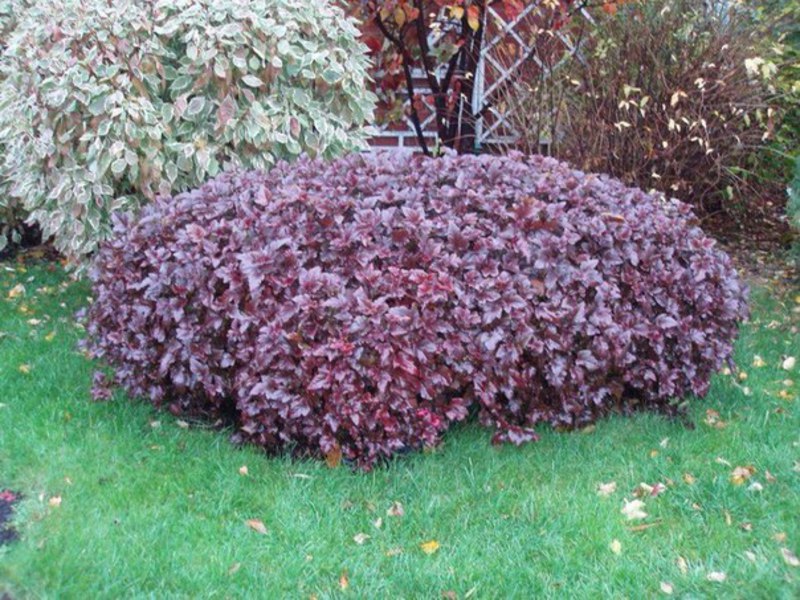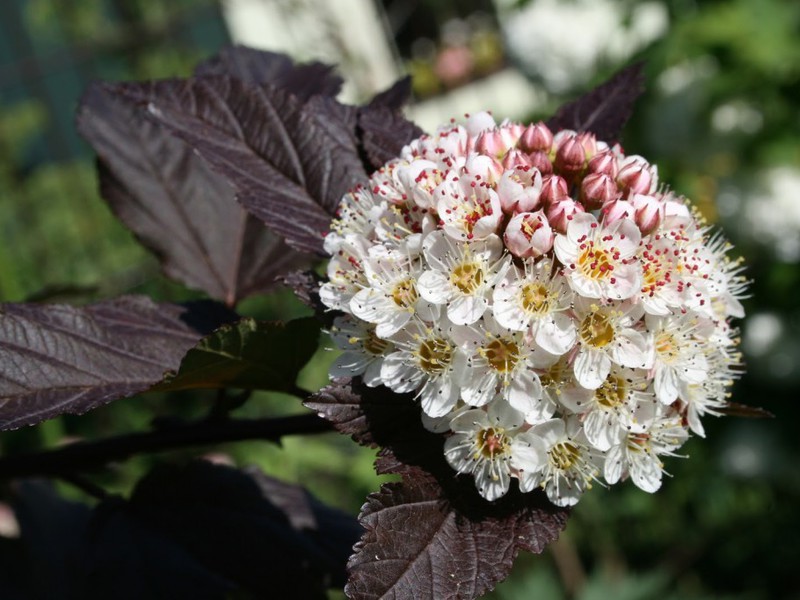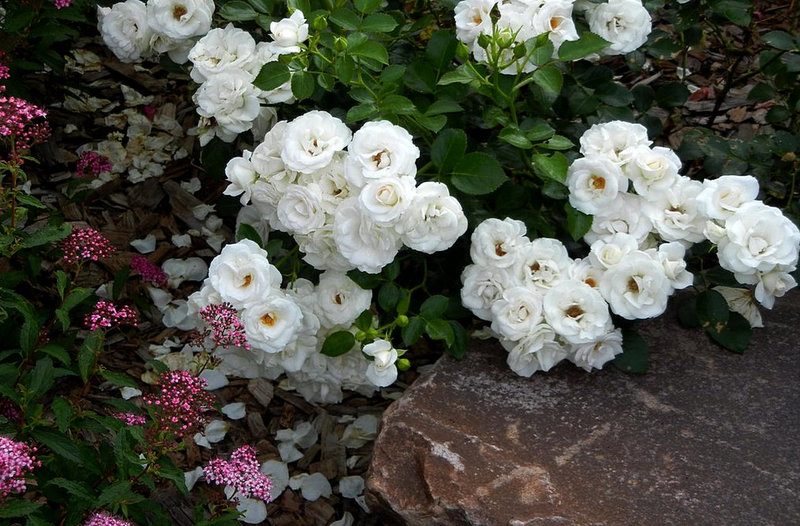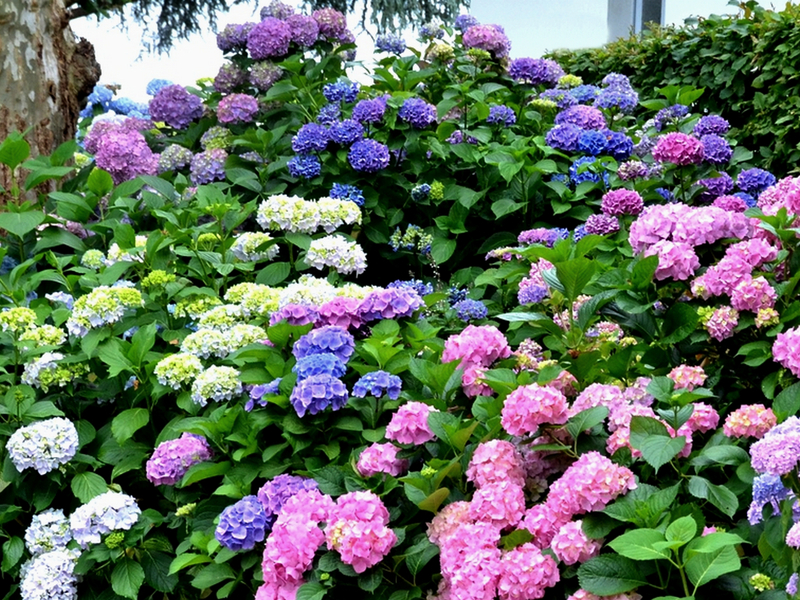If you have not yet had time to acquire a bladder, then hurry to do it if you want to get an additional reason for envy from your neighbors. Although the name of this plant evokes nothing but a smile, the attitude towards it will immediately change, one has only to see this giant, covered with a spectacular dense crown and spreading branches adorned with bright flowers and unpretentious corrugated leaves.
The bicarp is one of the notable representatives of the Rosaceae family, growing in the form of a deciduous shrub. This is a very unpretentious crop that thrives in all weather conditions: heat, drought and cold. This plant delivers unforgettable pleasure during the flowering period, when it is densely hung with flowers that remain on the brushes from early to mid-summer.
The name of the plant is interesting: it comes from the Latin words (physo: "bubble", and carpos: "fruit"). The fruits of the vesicle look very original, very similar to miniature glass balls, which, like leaves, are also capable of changing their color. Young plants, as a rule, are decorated with light-green bubbles, but the older the bladder, the richer their shade becomes, acquiring over time a green, red-pink and brown color.
Content
Application in landscape design
 It is no coincidence that the vesicle is widespread in landscape design. Due to the fact that it grows very quickly, a hedge of extraordinary beauty can be obtained already during the first season. This culture also looks good in solitary plantings, as well as as an element for decorating borders.
It is no coincidence that the vesicle is widespread in landscape design. Due to the fact that it grows very quickly, a hedge of extraordinary beauty can be obtained already during the first season. This culture also looks good in solitary plantings, as well as as an element for decorating borders.
Children can not help but pay attention to this plant. Finding themselves next to this shrub, they immediately have a desire to press on the core of the flower. From this, the fruits begin to burst, emitting loud claps, which are very similar to fireworks.
Therefore, if you plant this unusual plant in your home, then every day you will provide yourself with a holiday and beautiful fun.
Bladder types
A photo of this shrub shows how diverse it can be. But among them are especially interesting varieties.
Most often, in summer cottages and in the composition of various compositions, you can find such varieties of the bladder as Kalinolist and Amur. The first is one of the favorite plants of landscape designers who especially appreciate its attractive appearance in it.
- Vine-leaved vesicle... Of the features of this plant, it is worth highlighting thin, very lush branches and a crown in the form of a hemisphere. Flowers with a snow-white or pinkish hue also look attractive. They begin to bloom already in July, and with the onset of autumn, fruit balls form instead. This variety did not go unnoticed by breeders, who used it as a basis for breeding many varieties and shrubs with different leaf colors.
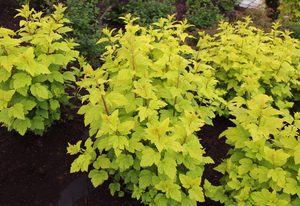 Golden Yellow Luteus... This variety looks unique due to its globular shape. Many people note that it strongly resembles untethered vines. The plant stands out for its majesty and luxurious appearance. For most of the growing season, it retains yellow leaves, which become greenish at the end of summer. Over time, the bark begins to peel off in the form of thin ribbons.
Golden Yellow Luteus... This variety looks unique due to its globular shape. Many people note that it strongly resembles untethered vines. The plant stands out for its majesty and luxurious appearance. For most of the growing season, it retains yellow leaves, which become greenish at the end of summer. Over time, the bark begins to peel off in the form of thin ribbons.- Purple Red Baron... This variety is deservedly popular due to its impressive appearance. He attracts attention with a variety of leaf colors, which can vary depending on how abundantly the shrub is illuminated by the sun. When grown in the shade, the leaves of the Red Baron bubble plant, instead of their original rich burgundy hue, acquire a mixed color in the form of a combination of green and red. However, in the fall, the foliage of this species of vesicle acquires a bronze color.
- Lemon Darts Gold... Most often, this unusual plant is used to create compact hedges that are no more than 2.5 meters high. Such hedges not only look beautiful, but also do not require special attention in the process of caring for the vesicle.
Planting and leaving
A photo of a shrub can acquaint everyone with its species diversity. After all, the choice of a variety is one of the main issues that need to be addressed. After all, planting and caring for the vesicle does not require special skills, since this culture already demonstrates amazing unpretentiousness.
Landing
The first step is to find a suitable place for the shrub, which must be well lit. In such conditions, he will be provided with the most favorable conditions for development, and the flowers will be brighter and more beautiful. It is recommended that you plan to plant the plant in the spring or fall. It is best to use seedlings that preserve varietal characteristics.
 Landing begins with preparation holes, which should have a depth of about 50 cm. If group plantings are planned, then the plants are placed no closer than 1.5-2 meters from each other; in relation to hedges, an interval of 0.8-1.2 meters is observed.
Landing begins with preparation holes, which should have a depth of about 50 cm. If group plantings are planned, then the plants are placed no closer than 1.5-2 meters from each other; in relation to hedges, an interval of 0.8-1.2 meters is observed.- Be sure to pour a layer of peat or humus on the bottom.
- The seedling directly with the old soil on the roots must be transferred to the hole.
- Young plants covered with soil mixture by 5 cm, after which they must be immediately watered with root, which will speed up rooting.
- The rest of the space needs to be filled with mulch, which is suitable for dry soil. Thanks to this procedure, it is possible to prevent the formation of a dry crust, which restricts the access of air to the roots.
Temperature, humidity
Due to its cold resistance, Diablo's vesicle is not afraid of frosts, as well as frosts in late autumn. Although the air temperature does not really matter to him, the searing, severe cold can seriously weaken him. This culture grows most actively at temperatures from + 17 to + 25 degrees Celsius.
Humidity has a similar effect on it. The viburnum bicarp tolerates fluctuations in air humidity well, therefore it grows without much change in both humid and dry climates.
Watering
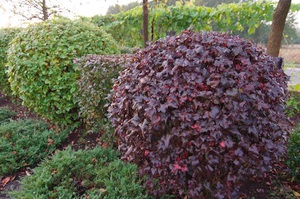 When choosing the optimal irrigation regime, it is necessary to proceed from the state of the soil. A shrub that is grown on dry, marginal soil needs more frequent watering. You need to spend a lot of water on plants, making sure that it gets right under the root.
When choosing the optimal irrigation regime, it is necessary to proceed from the state of the soil. A shrub that is grown on dry, marginal soil needs more frequent watering. You need to spend a lot of water on plants, making sure that it gets right under the root.
In especially dry years, it is necessary to continue watering until the end of autumn. But at the same time, you need to try to avoid stagnant water, since such growing conditions also do not benefit the plant.
Lighting
Due to its unpretentiousness, the viburnum bladder feels good both in conditions of partial shading and in open space.However, it is more preferable to grow it in areas with good sunlight. In response to this, the shrub will delight in the summer with bright colors and retain its rich shade until autumn.
Top dressing
The viburnum bicarp responds positively to frequent feeding. The first time fertilization is applied in early spring, with an emphasis on the use of fertilizers rich in nitrogen. When preparing a shrub for winter in the fall, it is necessary fertilize the bushes with mineral compounds.
- in the spring, fertilizing is carried out on the basis of ammonium nitrate. For this, a solution is prepared from one tablespoon of the substance, which is diluted in 10 liters of water. Be sure to add 0.5 liters of mullein and one tablespoon of urea to this mixture. The solution is applied at the root during the main watering;
- in the fall, it is recommended to feed the vesicle with a solution of nitrophoska, for the preparation of which they take 5 grams. or a full matchbox of fertilizer to be diluted in 10 liters of water.
When determining the rate of fertilizer consumption, it is necessary to proceed from the age of the plant. For older specimens of the Diablo variety, about 10-15 liters of fertilizer will be sufficient. For young plants, you can use no more than 10-12 liters of top dressing.
Pruning
During the care of the bladder, it is imperative to prune. This operation does little to injure the shrub, and the effect becomes more than noticeable - thanks to pruning, shrubs can be turned into beautiful shapes, hedges or curbs. If this procedure is carried out regularly, the vesicle acquires a denser and more compact shape.
 sanitary... It is carried out throughout the entire growing season, and its essence is to remove all old, broken branches;
sanitary... It is carried out throughout the entire growing season, and its essence is to remove all old, broken branches;- molding... This operation is planned in the fall, when the bush will completely bloom. In the first year, young shoots must be cut half the length. In the future, trimming is carried out no more than 2/3 of the length;
- anti-aging... Such pruning is carried out on shrubs over 5 years old. You can do it in the fall or early spring. To do this, you must completely cut the old branches to the base. All other shoots must be removed to those areas where the lateral branch begins to form.
If the bladder is grown as a hedge, then it should be trimmed no more than one or two times per season. The first time this operation is performed in April before the buds begin to bloom.
Reproduction
The most effective methods of propagation of the vesicle is the use of cuttings and transplanting layers.
- Cuttings... First you need to choose a bush that has well-developed side shoots. Next, you need to prepare the young twigs that have grown in the current year. They need to be placed in a container containing immunomodulators, such as root or zircon. This will help speed up the rooting process. After that, young seedlings are transplanted into a container, which is pre-filled with a mixture of peat and sand.
After transplanting, the soil must be well watered and covered with foil. In the future, it is necessary to keep the soil moist, and also periodically open the plantings for fresh air. In order for the seedlings to survive the winter well, they will have to be well covered in the fall. Provided that they successfully overwinter, in the spring it will be possible to look for them in a suitable place in the garden;
- Layers... The strongest young shoot is used for propagation of the vesicle by this method. It is imperative to remove all leaves from it with the exception of two or three located at the top. Not far from the mother plant, you need to prepare a hole 15 cm deep, into which the process is laid and fixed with a bracket. For the early rooting of young plants, it is recommended to propagate the vesicle by layering in early spring.
Conclusion
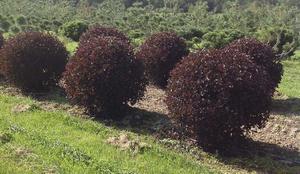 Unlike many traditional ornamental plants, very few gardeners are familiar with the bladder, most of whom are specialists. However, if you decide to plant this shrub on your site, you will not be disappointed with your choice. This plant will become the main decoration on your site. Moreover, you will not be disappointed by the difficulties that you face in the process of growing and caring for it.
Unlike many traditional ornamental plants, very few gardeners are familiar with the bladder, most of whom are specialists. However, if you decide to plant this shrub on your site, you will not be disappointed with your choice. This plant will become the main decoration on your site. Moreover, you will not be disappointed by the difficulties that you face in the process of growing and caring for it.
The bubblegum is a very unpretentious shrub, so it can be grown even in not very favorable areas, where many well-known ornamental crops feel uncomfortable. However, if you want to enjoy the rich bloom of the bubblegum, then it is best to choose a sunny location for it.
